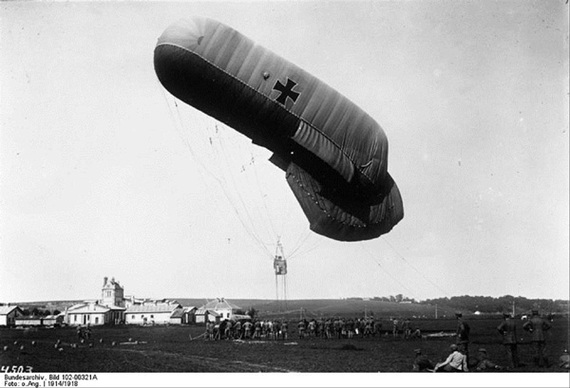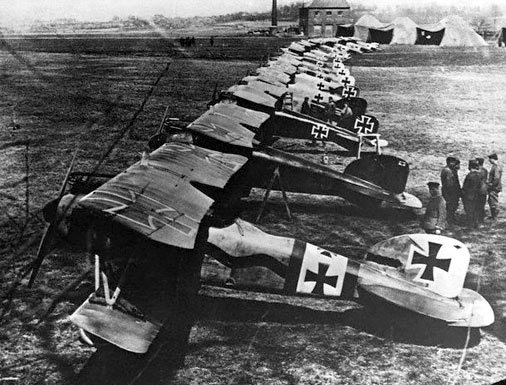Image may be NSFW.
Clik here to view.
German World War I Reconnaissance Balloon
The Emergence of Air Power
Man-carrying balloons had been under development for hundreds of years. By the start of the twentieth century, however, their safety and reliability had increased to such an extent that they had become a popular pastime. With the threat of war looming, the military turned its attention to these lighter-than-air crafts for observation and artillery spotting roles.
At the beginning of World War I, the lack of timely information on enemy troop movements was a problem for both sides. Raids on the enemy's trenches were often made to capture prisoners for interrogation. The intelligence obtained from such interrogations, however, was usually of limited value. More often than not, the prisoners knew even less than their interrogators about forthcoming plans.
With both sides facing each other in static positions across no-man's land and the trench lines, neither army had any timely warning of forces being brought up for an attack. Nor could they observe the construction of any new defensive lines or the accuracy of their long-range guns. Initial experiments were made with hoisting towers, but these were not tall enough to see over any high ground. The answer was the deployment of thousands of tethered observation balloons behind both the Allied and German lines. These carried one or two men aloft to an altitude of up to 3,000 feet. In clear weather they could observe over a considerable distance.
These balloons, however, were highly visible and as the war progressed they became the target of enemy fighters who were tasked with special "balloon busting" missions. For these early observers, survival in a hydrogen filled balloon under attack was virtually impossible until the introduction of parachutes. Since the balloons themselves were defenseless, the observer taking the photographs had to be quick to avoid a flaming death.
The Zeppelins
In the 1890's the Frenchmen Albert Spiess developed the design for a practical air ship. In Germany, Kaiser Wilhelm II had encouraged Count Ferdinand von Zeppelin to build airships of a similar design. When the war began, the German High Seas Fleet used Zeppelins for reconnaissance. They also supported the operations of the German U-boat blockade, spotting distant targets and providing coordinates for attacks on Allied shipping.
Beginning in 1915, the Zeppelins were also deployed to make long-range bombing raids against England, particularly Great Yarmouth, King's Lynn, and Hull, on the east coast and on London. The first attack on London came on May 31, resulting in seven people being killed and twenty-five injured. In all, fifty-two zeppelin raids were launched against England. In total 557 people were killed and 1,358 people were injured by these air raids. These missions had no military value and were used primarily as a form of psychological warfare against civilians. Following an average 24-hour mission across the North Sea, the Zeppelins returned to bases in Denmark or Schleswig-Holstein, where they were maneuvered into massive airship sheds by ground crews.
Great Britain also operated air ships. Britain's Royal Naval Air Service was engaged in the war at sea. Its task was spotting for the Royal Navy and also bombing German U-boats and German Zeppelin bases on the other side of the North Sea. By 1915, Britain had also built the first seaplane carrier, HMS Ark Royal. Later, a torpedo carrying capability would be added to give these first tiny airplanes a mighty punch.
Image may be NSFW.
Clik here to view.
German Albatross DIII
The Evolution of Air Power
Inventors had been experimenting with heavier-than-air manned flight for many years. Most of the craft were strange and bizarre machines, and most never got off the ground. It wasn't until 1903 that the Wright brothers in the United States achieved the goal of sustained powered flight. In less than fifteen years, this invention would revolutionize warfare, creating for the first time a three dimensional battlefield.
On July 23, 1909, the French aviator Louis Bleriot successfully flew across the English Channel. The barrier of the tempestuous channel had been breached. Great Britain's psychological sense of splendid isolation from continental Europe was no more. With World War I fast approaching, a truly practical airplane had arrived.
In August 1914 the German army possessed about 230 fixed-wing aircraft, but only around 180 were in a usable state. Britain was a late starter in aeronautics and relied largely on the French, especially for the manufacture of engines. The Royal Flying Corps had only been founded in 1912. In 1914, only three squadrons of about 30 aircraft were available to the RFC.
At the outbreak of war, the French Aeronautique Militaire had 21 escadrilles, or squadrons, with 132 machines. Used initially for reconnaissance with planes like the Farman MF.2, the service was quickly expanded to 65 squadrons and organized along four separate tasks; each with its own specialized aircraft: Morane-Saulniers would be used as fighters, Voisins as bombers, Farmans as reconnaissance aircraft and Caudrons as artillery spotters.
At the start of World War I the use of aircraft was limited to observation and to taking photographs of the trench lines and rear areas for later interpretation. Notwithstanding its limited use however, reconnaissance from the air, however, played a pivotal role in the early months of the war. An outstanding example of its usefulness came when 100,000 British, French and Belgium soldiers were saved from death or capture thanks to a timely British withdrawal towards Mons in Belgium. Aerial reconnaissance had provided critical information on German troop movements and an impending attack
.
As each side became more belligerent, the pilots and observers began to arm themselves. At first only pistols and rifles were used. Grenades and even grappling hooks were also employed. Soon machine guns were deployed and the era of air combat began.
Clik here to view.

German World War I Reconnaissance Balloon
The Emergence of Air Power
Man-carrying balloons had been under development for hundreds of years. By the start of the twentieth century, however, their safety and reliability had increased to such an extent that they had become a popular pastime. With the threat of war looming, the military turned its attention to these lighter-than-air crafts for observation and artillery spotting roles.
At the beginning of World War I, the lack of timely information on enemy troop movements was a problem for both sides. Raids on the enemy's trenches were often made to capture prisoners for interrogation. The intelligence obtained from such interrogations, however, was usually of limited value. More often than not, the prisoners knew even less than their interrogators about forthcoming plans.
With both sides facing each other in static positions across no-man's land and the trench lines, neither army had any timely warning of forces being brought up for an attack. Nor could they observe the construction of any new defensive lines or the accuracy of their long-range guns. Initial experiments were made with hoisting towers, but these were not tall enough to see over any high ground. The answer was the deployment of thousands of tethered observation balloons behind both the Allied and German lines. These carried one or two men aloft to an altitude of up to 3,000 feet. In clear weather they could observe over a considerable distance.
These balloons, however, were highly visible and as the war progressed they became the target of enemy fighters who were tasked with special "balloon busting" missions. For these early observers, survival in a hydrogen filled balloon under attack was virtually impossible until the introduction of parachutes. Since the balloons themselves were defenseless, the observer taking the photographs had to be quick to avoid a flaming death.
The Zeppelins
In the 1890's the Frenchmen Albert Spiess developed the design for a practical air ship. In Germany, Kaiser Wilhelm II had encouraged Count Ferdinand von Zeppelin to build airships of a similar design. When the war began, the German High Seas Fleet used Zeppelins for reconnaissance. They also supported the operations of the German U-boat blockade, spotting distant targets and providing coordinates for attacks on Allied shipping.
Beginning in 1915, the Zeppelins were also deployed to make long-range bombing raids against England, particularly Great Yarmouth, King's Lynn, and Hull, on the east coast and on London. The first attack on London came on May 31, resulting in seven people being killed and twenty-five injured. In all, fifty-two zeppelin raids were launched against England. In total 557 people were killed and 1,358 people were injured by these air raids. These missions had no military value and were used primarily as a form of psychological warfare against civilians. Following an average 24-hour mission across the North Sea, the Zeppelins returned to bases in Denmark or Schleswig-Holstein, where they were maneuvered into massive airship sheds by ground crews.
Great Britain also operated air ships. Britain's Royal Naval Air Service was engaged in the war at sea. Its task was spotting for the Royal Navy and also bombing German U-boats and German Zeppelin bases on the other side of the North Sea. By 1915, Britain had also built the first seaplane carrier, HMS Ark Royal. Later, a torpedo carrying capability would be added to give these first tiny airplanes a mighty punch.
Image may be NSFW.
Clik here to view.

German Albatross DIII
The Evolution of Air Power
Inventors had been experimenting with heavier-than-air manned flight for many years. Most of the craft were strange and bizarre machines, and most never got off the ground. It wasn't until 1903 that the Wright brothers in the United States achieved the goal of sustained powered flight. In less than fifteen years, this invention would revolutionize warfare, creating for the first time a three dimensional battlefield.
On July 23, 1909, the French aviator Louis Bleriot successfully flew across the English Channel. The barrier of the tempestuous channel had been breached. Great Britain's psychological sense of splendid isolation from continental Europe was no more. With World War I fast approaching, a truly practical airplane had arrived.
In August 1914 the German army possessed about 230 fixed-wing aircraft, but only around 180 were in a usable state. Britain was a late starter in aeronautics and relied largely on the French, especially for the manufacture of engines. The Royal Flying Corps had only been founded in 1912. In 1914, only three squadrons of about 30 aircraft were available to the RFC.
At the outbreak of war, the French Aeronautique Militaire had 21 escadrilles, or squadrons, with 132 machines. Used initially for reconnaissance with planes like the Farman MF.2, the service was quickly expanded to 65 squadrons and organized along four separate tasks; each with its own specialized aircraft: Morane-Saulniers would be used as fighters, Voisins as bombers, Farmans as reconnaissance aircraft and Caudrons as artillery spotters.
At the start of World War I the use of aircraft was limited to observation and to taking photographs of the trench lines and rear areas for later interpretation. Notwithstanding its limited use however, reconnaissance from the air, however, played a pivotal role in the early months of the war. An outstanding example of its usefulness came when 100,000 British, French and Belgium soldiers were saved from death or capture thanks to a timely British withdrawal towards Mons in Belgium. Aerial reconnaissance had provided critical information on German troop movements and an impending attack
.
As each side became more belligerent, the pilots and observers began to arm themselves. At first only pistols and rifles were used. Grenades and even grappling hooks were also employed. Soon machine guns were deployed and the era of air combat began.